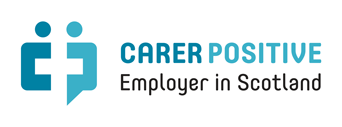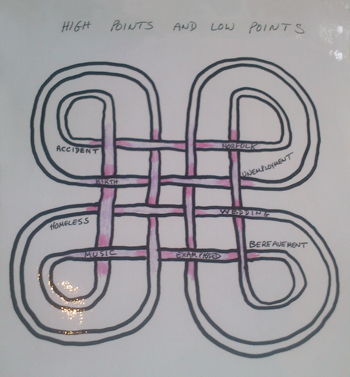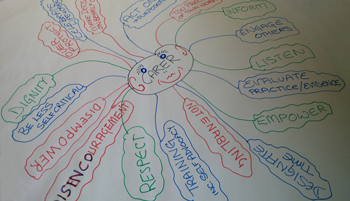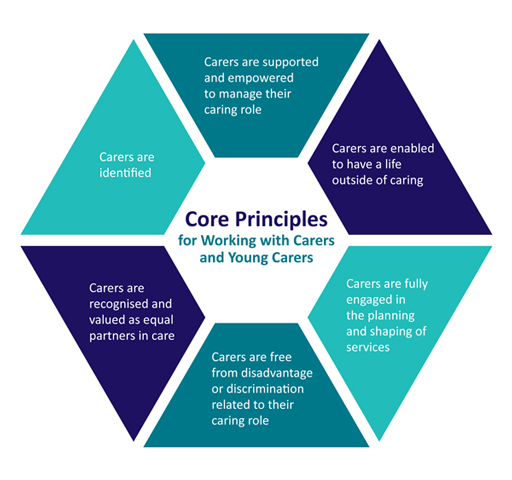Use 'Print preview' to check the number of pages and printer settings.
Print functionality varies between browsers.
Printable page generated Thursday, 27 November 2025, 10:46 AM
Guide for facilitators
Guide for facilitators
This short guide provides information and advice for facilitators on how to make the best use of the course when working with individuals or groups.
What is Caring Counts in the Workplace?

This is a flexible online course built around the stories and experiences of a range of carers who share their lives in text and on film. Some activities take the learner through a process of self-reflection, while others encourage the learner to reflect on the knowledge and skills carers may gain from their caring role, and the challenges they may face combining their caring and work roles, and the role of managers in supporting them to do this.
The course can be used by learners individually or in facilitated groups – or a combination of the two. There are five sessions, which could be completed as an intensive one-day course or over a few weeks. Some ideas on how it might be used are set out below. The course is designed to be used online, but can be downloaded and used without internet access using a computer, on a tablet or an e-reader, or printed out and completed with just pen and paper. The course is completely free.
We have provided an online Reflection Log for learners to reflect on their activities and learning as they progress through the course, saving the updated document as they go along. For those who prefer to work off-line this document can be downloaded and printed off, or learners can simply use pen and paper to record their reflection and planning journey.
The process of reflection will help learners to identify and value the skills and qualities carers develop through their caring role, and their own role in supporting carers in the workplace.
Learners are invited to answer questions at the end of each section. These are mostly multiple choice or matching exercises, which are designed to be enjoyable. These online quizzes are optional but must be completed successfully for the learner to receive a digital badge for the course.
Who is the course for?
Caring Counts in the Workplace is for managers and policy makers who are interested in finding out more about carers, and understanding their own role in identifying and supporting carers in the workplace. This course will help learners to reflect on their current and future practice.
This course links to the criteria for the Carer Positive award for Scottish employers, which is awarded to Scottish employers and organisations who support carers in their workforce.

The final session will help learners to develop an action plan for creating a Carer Positive workplace. It also links to the Core Principles for Working with Carers and Young Carers, which is a framework developed by NHS Education for Scotland (NES) and the Scottish Social Services Council (SSSC) to support workforce awareness of carers.
How long does it take?

There is no fixed time. It could take about five hours delivered as a one-day course or more spread over several weeks. Learners working through the course online may spend much less time. It depends on how the course is delivered. There are suggested times for how long activities might take but learners may take much longer. We would suggest that the course is spread over a few weeks so that learners can mull over ideas and thoughts as they progress. A combination of self-directed learning and facilitated sessions would give learners the opportunity to discuss their thoughts and reflections with the group.
How can workplaces use this course?
We suggest that the facilitator completes the course in the first instance, to get an idea of how it might fit with other courses and resources you already offer for managers.
The course is flexible and adaptable, and allows you to think about how best to promote it and integrate it into your workforce learning programme. If you are considering applying to become a Carer Positive workplace, this course would be particularly useful for line managers and those in HR in your organisation.
The ideas below have been suggested by facilitators of the Caring Counts: a self-reflection and planning course for carers, on which this course is based.
- Use it on a one-to-one basis, acting as mentor to a learner who is keen to reflect on their practice.
- Incorporate it into other workforce learning you run for line managers.
- Deliver it online to a group of learners who do not share a base. You could think about using social media, email, phone or even develop a webinar to talk through the course and support learners who can’t meet in person.
- You don’t have to deliver it at set times, but you can discuss key parts of the course while learners work at their own pace at home or within the group.
- Make the course available on your workforce learning platform, if you have one. This would allow learners to access it in their own time as part of their continuing professional development.
- Pick out the parts of the course that meet your learners’ needs.
Each session contains a number of activities as well as reflection tasks. Learners could work individually on the reflections, then work as a group to complete the activities. You can encourage learners to discuss their reflections with the wider group if they feel comfortable doing this.
What do learners get if they finish the course?
Caring Counts in the Workplace badge

Completing the online quizzes in order to gain the Caring Counts in the Workplace badge is optional. However, we know that recognition for continuous professional development is important to learners. The Caring Counts in the Workplace badge shows that learners have gained an understanding of carers in the workplace, the Carer Positive, and the Core Principles for Working with Carers and Young Carers, and have achieved the learning outcomes listed within the course.
You can find out more about how to complete the quizzes and how to gain a badge in the introduction section of the course and on these pages:
- Badges and quizzes
- How to complete the course quizzes
- How your Caring Counts in the Workplace badge is issued.
If learners complete the quizzes successfully they will gain a digital badge for the course.
Reflection Log
Learners will be able to record their thoughts and plans for their future in their Reflection Log. This doesn’t have to be completed on a computer – it can be done on the downloaded document or simply with pen and paper.
This learning should help them to plan their next steps, particularly if the organisation is applying for the Carer Positive kitemark. Learners should finish the course with an action plan for this. If they are not doing the course for this reason, the Reflection Log will help them to reflect on their own practice in supporting carers.
How do you start?
Learners working individually can just go online and get started by clicking on the Caring Counts in the Workplace website. However, we recommend that each learner creates their own Open University account and formally enrols on the course. By doing so they’ll be able to complete the online course quizzes and gain the digital course badge for successful completion. Having their own Open University account also makes it easier and quicker for them to access additional Open University courses and resources, including careers advice. Instructions on how to create an account and how to enrol on the course are available in the Badges and quizzes section.
Learners will need access to a computer and a printer to save and print their individual activities or their completed Reflection Log at the end of the course.
Learners can start and stop the course as they like. It’s completely flexible and there’s no time limit. Repeat a section, print sections off, photocopy them or project the course from a computer for shared viewing – it’s up to you and the learners completing the course.
Facilitating activities
Each session contains a number of activities, all of which are outlined in the Reflection Log. If you are delivering this course in a blended format, where the learners undertake some of the course online and some in face-to-face sessions, many of the activities are suitable to carry out with a group of learners.
Some are reflection activities, which learners can do on their own, though they may be interested in discussing them afterwards with the group. You should set some ground rules before these discussions take place to help learners feel more comfortable sharing their thoughts. You might want to discuss with the group what might be included in these ground rules. For example:
- Learners should only discuss what they feel comfortable with. If they have reflected on aspects of their personal lives, they do not have to share these with the group. It is fine to focus on certain aspects, such as their work life, in discussions.
- When sharing examples from their practice, learners should respect the privacy of the individuals involved. Don’t use their names, or details that may identify them, and don’t share information that is confidential.
- Anything shared with the group stays within the room. Learners should trust that what they say will not be shared with others.
- Issues may arise that learners may decide to take forward more formally. You may need to be aware of the mechanisms for this in your organisation, or how to signpost to the appropriate person or department.
In the following sections we have provided some tips for facilitating the activities under each session of Caring Counts in the Workplace.
Session 1

Activity 1.1 Thinking about myself
Time: Depending on the size of the group and their enthusiasm, you could allow between 20–40 minutes for this activity (excluding reflection time).
This activity can be done as a personal reflection, using the table provided in the Reflection Log. Learners could then bring it back to the group for discussion. Alternatively, learners’ thoughts could be represented visually and this could be done, after the reflection, as part of a group.
One idea is to create a mood or vision board. This can be a fun and creative way for learners to get insight into their thinking. Encourage them to flick through the magazines until they see images or words that catch their attention. They can cut or tear that page out, gathering pictures and words that summarise their thoughts. Sometimes a creative activity can release thoughts or ideas that people find difficult to put into words.
Before the session, you will need to gather (or ask learners to bring) a range of catalogues, magazines and newspapers, some scissors, glue, coloured paper, maybe even some glitter!
Session 2

Activity 2.1 My timeline
Time: 20–30 minutes, depending on the methods used.
Having looked at the carers’ timelines in the course, it may be interesting for learners to draw their own timeline. They should reflect on this before the group activity.
What they add to their timeline is up to them – they can focus on just their career, or they can incorporate their childhood and family life if they choose, their whole lives or a specific period. It may be that some learners will identify that they have a caring role themselves and will want to explore this. It’s entirely up to them what they choose to represent.
The timeline can be done is a number of ways. You can work as a group or allow learners to choose the method they prefer:
- Using a pen and paper, position positive experiences higher than negative ones to create a simple timeline (there is a template in the Reflection Log).
- On a computer, using Microsoft Word or a similar programme, the timeline can be represented as a diagram.
- Another option is to use bubbl.us, which is free online software, to create images.
- Think of creative ways to visualise the timelines, getting as artistic as you want. Some learners have produced timelines using Celtic strapwork, with the low points going under the high points to create a pattern
If learners are working online, remind them to save and/or print out their timelines as they will be referring to them in other activities.
Before the session: If you are working offline, you will need paper, pens of different colours, and templates if you are using them. If working online make sure there is access to a printer.
Activity 2.2 Learning from the caring experience
Time: 10–15 minutes

This is can be a reflection or a discussion activity. Having listened to Lesley talk about what she has learned from her caring experience, learners can discuss the following:
- Was some of Lesley’s learning unexpected?
- Did she learn from difficult times as well as good ones?
- Did Lesley learn things while caring that will be useful in studying and employment?
You can prompt the discussion, picking up on some key words from Lesley’s story, such as: resilient, managing her time, budgeting, managing stress, capable of learning, coping with difficult situations, communication skills.
Activity 2.3 Learning from my experience
Time: 10–15 minutes
This is an optional activity. Having looked at carers’ life experiences, learners may find it interesting to try this activity for themselves, revisiting their timeline and thinking about what skills and qualities they have learned from their experiences.
They can add their learning points to their timeline using a different colour. Remind them to save their timeline if doing this activity online.
Learners may prefer to do this activity alone, but you can invite them to share and discuss their learning points with the group if they feel comfortable doing this.
Session 3

All the activities in Session 3 are reflection activities.
Activities 3.1–3.3
Time: 10–15 minutes for each activity
Having reflected, encourage learners to share their thoughts with the group, or you can use the reflection questions to facilitate discussions of about 15 minutes each.
Activity 3.4 Reflection on carers’ personal qualities in the workforce
Time: 10–15 minutes
This activity could be carried out either as a discussion or as a group activity.
Using the resource The SCQF: A Guide for Employers, which maps skills to qualifications, you can encourage the group to identify the skills, qualities and attributes of carers and link them with those they would recognise in their own workforce.
Session 4
Activity 4.1 Reflection on carers’ skills, qualities and attributes developed through their caring role
Time: 10–15 minutes
Can be carried out either as a discussion or as a group activity.

Using the list of skills, qualities and attributes that a social worker would need, learners can reflect on or discuss how Naomi’s caring experience might help prepare her for a career in social work.
Activity 4.2 Looking at person specifications
Time: 30 minutes
If you are delivering this course to learners from the same organisation or sector, this activity can be carried out in pairs or small groups. If each learner has a different background, it might be easier for them to do the activity on their own and discuss their thoughts with the group afterwards.
Bearing in mind what they have learned about the carers’ and their experiences in a caring role, encourage the learners to consider what carers may bring to their organisation(s).
Each learner or small group should identify a person specification for a job in their organisation. Exploring the information in the person specification, they should respond to the following questions:
- What knowledge, skills, qualities and attributes are required in the person specification?
- What might someone with experience of caring bring to the role?
- What kinds of question could an interview panel ask to identify some of these things during recruitment?
A table is provided in the Reflection Log that learners can complete individually or in small groups.
Activity 4.3 Factors that help or hinder carers
Time: 10–15 minutes
This is a reflection activity that can also be done as a group discussion.
Thinking of the carers you have met during the course, or carers that you know or support at work, think about some of the factors that may help or hinder them.
You can prompt the discussion with some of the factors listed in Session 4.
Activity 4.4 Support network
Time: 10–15 minutes
This would work well as a group activity. Having explored the different supports available to carers, break into small groups of 3–5 and provide each group with flip-chart paper and pens in different colours.
Each group should draw a ‘spider diagram’ with the carer in the centre.
Using one colour, learners should draw a ‘leg’ for each of the supports available for carers in their workplace that they are aware of.
Using another colour, they can add ‘legs’ to represent other sources of support they have explored in the session, such as family networks, carer centres, community organisations or statutory services.
Considering the example of the Scottish Court Service in Session 3, and any other ideas the group may come up with, they can use another colour to add support that their organisation could possibly provide for carers in the future.
Before drawing the spider diagram, you can give them some points to consider:
- What skills and qualities should a supportive line manager have (such as tact, sensitivity, empathy, ability to build mutual trust and respect, communication skills, fairness, reflective)?
- What factors might you need to consider when supporting a carer in your workforce (such as impact on rest of the team, workload, staff awareness, supportive culture, policies)?
Remind learners that they should respect the privacy of carers they manage and not share identifiable information with the rest of the group.
Session 5
Activity 5.1 My action plan
Time: 30 minutes
This is another activity that can be done as a group if the learners all come from the same organisation. Otherwise, it may be best done individually or in small groups of learners from the same organisation. Learners can then share their ideas for action with the group.
There is a template for an action plan in the Reflection Log. This is based on the criteria for creating a Carer Positive workplace under the following headings:
- Identification of carers
- Policy
- Workplace support
- Communication, awareness raising and training
- Peer support
This is a useful exercise for learners to identify steps they will take to put what they have learned on the course into practice, even if their organisation does not intend to apply for the Carer Positive status.
Activity 5.2 Reflection on my practice
Time: 30 minutes
This is an activity for learners to reflect on their own practice, and how well they demonstrate the Core Principles for Working with Carers and Young Carers. This can also be carried out as a group activity, using the image of the Core Principles to stimulate discussion.
Before the activity, print out or draw a large image of the Core Principles hexagon below. If you click on the link to the larger image, then right click on that image you will be able to save it to your desktop and print it out.
You will also need:
- a copy of Level 3 of the Core Principles framework
- some post-it notes
- coloured pens.
It would be useful for you to familiarise yourself with the Core Principles, which are intended to provide a framework to support workforce learning and practice with carers (read more about the Core Principles).
Encourage the group to reflect on some of the knowledge, skills and qualities that they use in their roles as employers and managers. You can use the knowledge and skills outlined in Level 3 of the Core Principles framework to prompt discussion, such as:
- Promoting carer awareness training for all staff
- Supporting carers in your workforce to manage their caring role
- Working with carers to identify how your organisation can support them to have time out from caring
- Ensuring that carers are free from disadvantage or discrimination related to their caring role
- Evaluating how well you involve carers and addressing any barriers
- Demonstrating the Core Principles in your own practice.
After the discussion, learners write on the post-it notes the skills and knowledge they use in the workplace. Using the large image of the Core Principles, they can attach the post-its to the relevant principle. This will create a visual representation of the extent to which they demonstrate the Core Principles in their practice.
Feedback and find out more
Although you don’t have to register your workplace or yourself as a facilitator, it would still be great to hear from you.
We’d like your feedback about how you’re using the course, so please complete our facilitator survey. It shouldn’t take you long to complete.
You may find supporting resources on:
- OpenLearn
- Carer Positive
- Equal Partners in Care
- SCQF Guide for Employers – this can help learners to map carers’ skills and attributes to qualifications that are relevant to their workforce.
Acknowledgements
Caring Counts: a reflection and planning course for carers was written by Lindsay Hewitt and Sarah Burton, quizzes by Julie Robson, The Open University.
This course was redeveloped to create Caring Counts in the Workplace in collaboration with Gill Ryan from NHS Education for Scotland and the Scottish Social Services Council’s Equal Partners in Care project, together with Sue McLintock (Carers Scotland) from the Scottish Government’s Carer Positive initiative.
Except for third party materials and otherwise stated (see terms and conditions), this content is made available under a Creative Commons Attribution-NonCommercial-ShareAlike 4.0 Licence.
The material acknowledged below is Proprietary and used under licence (not subject to Creative Commons Licence). Grateful acknowledgement is made to the following sources for permission to reproduce material in this unit:
Images
Figure 1: Ross Finnie for © The Open University
Figure 2: © Carer Positive, Carers UK 2015
Figure 3: © iStockphoto.com
Figure 4: Badge illustration © The Open University
Figure 5: © Revensis/Dreamstime.com
Figure 6: © Marek Uliasz/Dreamstime
Figure 7: © iStockphoto.com
Figure 8: Gill Ryan for © The Open University
Figure 9: Ross Finnie for © The Open University
Figure 10: © Logorilla/iStockphoto.com
Figure 11: © The Open University/Library image (model image only)
Figure 12: Gill Ryan for © The Open University
Figure 13: © NHS Education for Scotland 2013
Every effort has been made to contact copyright owners. If any have been inadvertently overlooked, the publishers will be pleased to make the necessary arrangements at the first opportunity.
Don’t miss out:
1. Join over 200,000 students, currently studying with The Open University – http://www.open.ac.uk/ choose/ ou/ open-content
2. Enjoyed this? Find out more about this topic or browse all our free course materials on OpenLearn – http://www.open.edu/ openlearn/
3. Outside the UK? We have students in over a hundred countries studying online qualifications – http://www.openuniversity.edu/ – including an MBA at our triple accredited Business School.
4. Carer Positive Find out more about the award for employers http://www.carerpositive.org/
5. Equal Partners in Care Find out more about the Scottish framework for learning and practice with carers and young carers www.knowledge.scot.nhs.uk/ equalpartnersincare or www.ssks.org.uk/ equalpartnersincare



